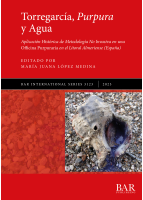Description
This is an open access title available under the terms of a CC BY-NC-ND 4.0 License. It is free to read, download and share on the BAR Digital platform here.
A lo largo de la costa del sureste de la Península Ibérica existen numerosos restos vinculados a la producción de la purpura. Este estudio se centra en el yacimiento de Torregarcía (Almería, España), situado en el Parque Natural de Cabo de Gata-Níjar, una zona costera protegida de especial interés ecológico. Torregarcía se excavó inicialmente en 1990 y se identificó como una factoría romana de salazones en la que también se practicaba la actividad complementaria del tinte. A pesar de su importancia, ha pasado desapercibida en la historiografía de las últimas tres décadas y nunca ha sido objeto de una publicación científica. Las investigaciones presentadas en este libro se han llevado a cabo mediante técnicas de prospección no invasivas, como el georradar (GPR), y han revelado la importancia de la explotación del tinte púrpura como actividad principal del yacimiento. También se describen instalaciones más complejas asociadas a las estructuras excavadas y a un gran conchero. Junto a éstas, además, se han documentado otras construcciones y concheros. Todo ello conforma el denominado por nosotros "paisaje de la purpura" en el litoral del Sureste peninsular, que permite al Parque Natural mostrar un excelente patrimonio arqueológico más allá de las excavaciones realizadas hasta la fecha.
Along the coast of the southeast of the Iberian Peninsula, there are numerous remains linked to the manufacture of purple dyes. This study focuses on the site of Torregarcía (Almería, Spain), located in the Cabo de Gata-Níjar Natural Park, a protected coastal area of particular ecological interest. Torregarcía was initially excavated during 1980s and was identified as a Roman salting factory where the complementary activity of dyeing was also practised. Despite its importance, it has gone unnoticed in the historiography of the last three decades and has never been the subject of dedicated scientific publication. The investigations presented in this book have been carried out using non-invasive prospecting techniques, such as ground-penetrating radar (GPR), and have revealed the importance of the exploitation of purple dye as the main site activity. More complex installations associated with the excavated structures and a large shell pit are also described. Alongside these, other buildings and shells have also been documented along the coastline of this site. All of this forms what we call the "purple landscape" in the southeast of the peninsular coast, which allows the Natural Park to show archaeological heritage beyond any excavations carried out to date.
EDITOR
María Juana López Medina es Profesora Titular de Historia Antigua (Dpto. de Historia, Historia y Humanidades) en la Universidad de Almería, España. Su actividad investigadora se centra en el análisis del territorio de época romana en el sur de la Península Ibérica, incluyendo la reconstrucción paleoambiental y el control y gestión del agua en el sureste peninsular.
María Juana López Medina is a Senior Lecturer of Ancient History (Dept. of History, History and Humanities) at the University of Almería, Spain. Her research activity focuses on analysing the territory of the Roman period in the south of the Iberian Peninsula, including palaeoenvironmental reconstruction and the control and management of water in the southeast of the Iberian Peninsula.
Contributors: Enrique Aragón Núñez, Francisco Javier Catalán González, Manuela García Pardo, Lázaro G. Lagóstena Barrios, María Juana López Medina, Diego Moreno Lampreave, María de la Paz Román Díaz, Lluís Pons Pujol, Manuel Ruiz Barroso, José Antonio Ruiz Gil, Isabel Rondán Sevilla, Pedro Trapero Fernández
REVIEWS
‘The purple production center of Torregarcía is going to be a reference example in the West Mediterranean area. The combination of different methodologies, most of them non-destructive, is an outstanding example of good practice’ Professor Oriol Olesti, Universitat Autònoma de Barcelona
‘Although other known or suspected purple factories have been identified in various parts of the Mediterranean, the present report represents a very detailed and scientific treatment of an unusually well-preserved installation in southeastern Spain. The intensive study of this site is a significant contribution to our understanding of the production of purple in the period of the Roman Empire.’ Professor Leonard Curchin, University of Waterloo











